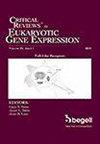SIAH2 介导的 ACSL4 降解抑制 CD8+ T 细胞在肝细胞癌中的抗肿瘤活性
IF 1.5
4区 医学
Q4 BIOTECHNOLOGY & APPLIED MICROBIOLOGY
Critical Reviews in Eukaryotic Gene Expression
Pub Date : 2024-02-01
DOI:10.1615/critreveukaryotgeneexpr.2024051981
引用次数: 0
摘要
SIAH2 在多种癌症中发挥着癌基因的功能。然而,SIAH2在肝细胞癌(HCC)中的作用尚不清楚。本研究旨在探讨 SIAH2 在 HCC 中的作用。研究采用免疫组化法测定临床样本中 SIAH2 和 ACSL4 的表达。RT-qPCR 用于测定 mRNA 表达。采用 Western 印迹法测定蛋白质表达。泛素化检测用于确定 ACSL4 的泛素化。异种移植实验用于确定肿瘤的生长情况。流式细胞术用于确定 CD8+ T 细胞的功能。SIAH2在HCC肿瘤中表达过高。高水平的SIAH2预示着较差的预后。然而,敲除 SIAH2 可促进 CD8+ T 细胞的增殖,并促进肿瘤细胞的铁变态反应,从而抑制 HCC 肿瘤的生长。CD8+ T细胞介导的HCC细胞铁凋亡需要ACSL4。然而,SIAH2 会诱导 ACSL4 泛素化并抑制其表达。花生四烯酸和 MEN 能协同促进免疫检查点阻断。SIAH2 介导的 CD8+ T 细胞失活抑制了 HCC 的铁凋亡。因此,靶向 SIAH2 可能是治疗 HCC 的一种有前景的策略。本文章由计算机程序翻译,如有差异,请以英文原文为准。
SIAH2-mediated degradation of ACSL4 inhibits the anti-tumor activity of CD8+ T cells in hepatocellular carcinoma
SIAH2 function as an oncogene in various cancer. However, the roles of SIAH2 in hepatocellular carcinoma (HCC) is still unknown. This study aimed to investigate the roles of SIAH2 in HCC. Immunohistochemistry was used determine SIAH2 and ACSL4 expression in clinical samples. RT-qPCR was used to determine mRNA expression. Western blot assay was applied for determined protein expression. Ubiquitination assay was conducted for determining ubiquitination of ACSL4. Xenograft experiment was applied for determining tumor growth. Flow cytometry was applied to determine the functions of CD8+ T cells. SIAH2 expression was overexpressed in HCC tumors. High levels of SIAH2 predicted poor outcomes. However, SIAH2 knockdown promoted the proliferation of CD8+ T cells as well as promoted the ferroptosis of tumor cells, inhibiting tumor growth in HCC. ACSL4 is required for CD8+ T cell-mediated ferroptosis of HCC cells. However, SIAH2 induced ubiquitination of ACSL4 and inhibited its expression. Arachidonic acid and MEN synergistically promoted the immune checkpoint blockade. SIAH2-mediated inactivation of CD8+ T cells inhibits the ferroptosis of HCC. Therefore, targeting SIAH2 may be a promising strategy for HCC.
求助全文
通过发布文献求助,成功后即可免费获取论文全文。
去求助
来源期刊

Critical Reviews in Eukaryotic Gene Expression
生物-生物工程与应用微生物
CiteScore
2.70
自引率
0.00%
发文量
67
审稿时长
1 months
期刊介绍:
Critical ReviewsTM in Eukaryotic Gene Expression presents timely concepts and experimental approaches that are contributing to rapid advances in our mechanistic understanding of gene regulation, organization, and structure within the contexts of biological control and the diagnosis/treatment of disease. The journal provides in-depth critical reviews, on well-defined topics of immediate interest, written by recognized specialists in the field. Extensive literature citations provide a comprehensive information resource.
Reviews are developed from an historical perspective and suggest directions that can be anticipated. Strengths as well as limitations of methodologies and experimental strategies are considered.
 求助内容:
求助内容: 应助结果提醒方式:
应助结果提醒方式:


